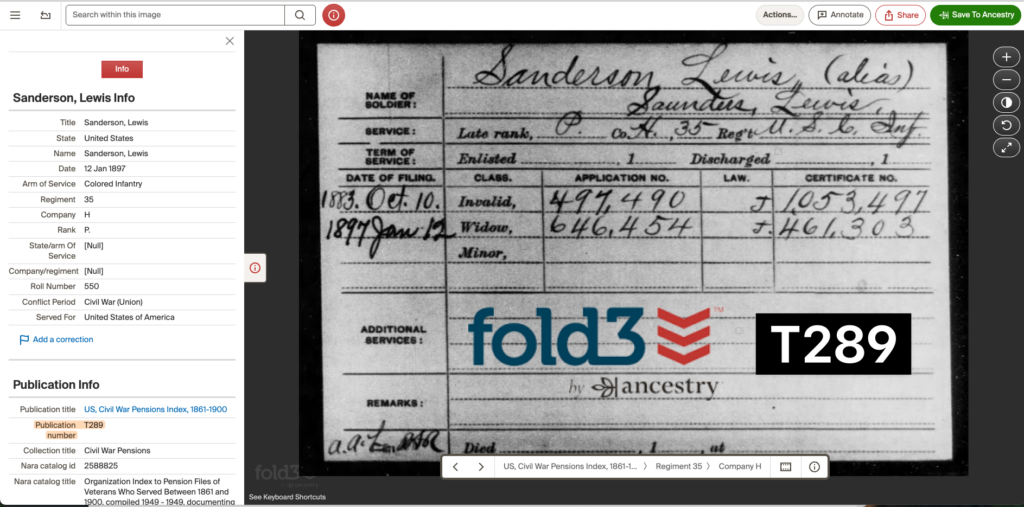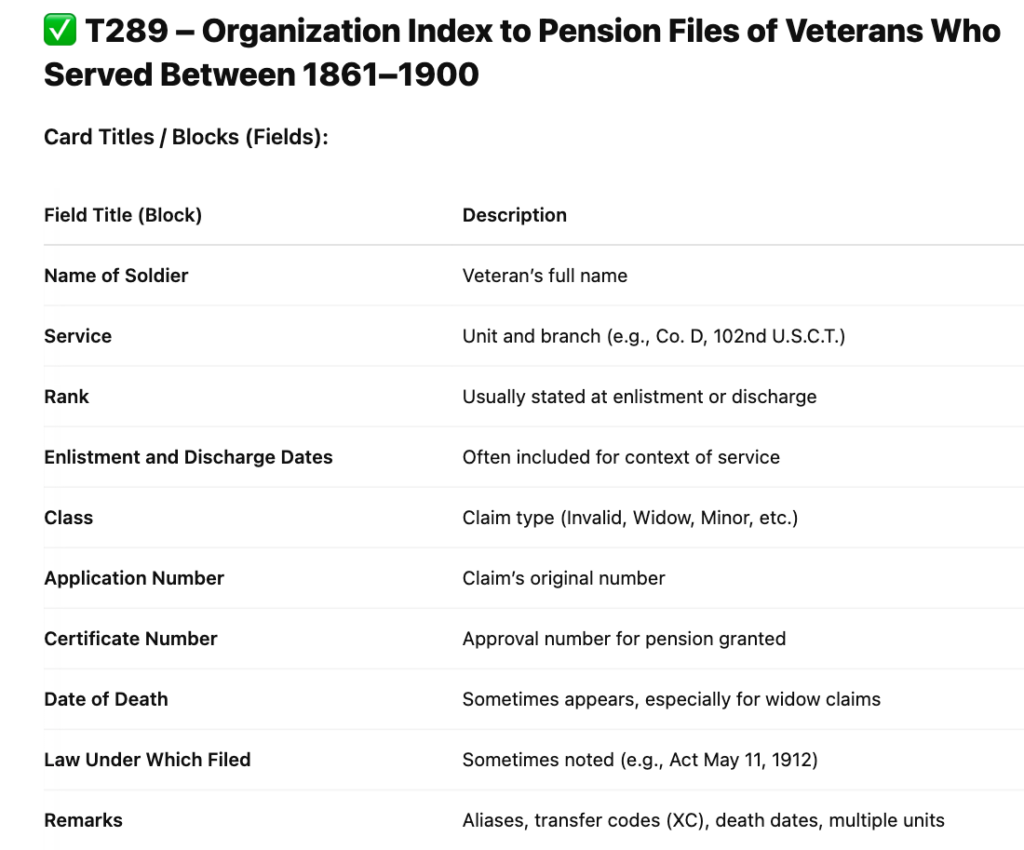Organizational Index - T289
The “Organizational Index to Pension Files of Veterans Who Served Between 1861 and 1900”
This index consists of pension cards for veterans who served in various military conflicts and peacetime periods between 1861 and 1900. It includes veterans of the Union Army during the Civil War, as well as those who served in the Spanish-American War, the Philippine Insurrection, and in the Regular Army during peacetime. Despite its title, the index also contains a small number of records from the Indian Wars and even includes some entries from World War I (1917).
| Pension Law Timeline and Impact on USCT | ||
| Year | Pension Law Milestone | Impact on USCT and Black Nurses |
| 1862 | Act of July 14, 1862 – Established the General Law pension system for Civil War veterans and dependents of those who died in service. | USCT veterans and their families qualified under this law, though racial barriers often delayed or denied access. Widows and dependents faced heightened scrutiny. |
| 1872 | Act of January 25, 1872 – Allowed lump sum back payments from date of death or discharge, in addition to monthly pensions. | Broader definitions allowed more USCT veterans to qualify, but racial bias in evaluations persisted. |
| 1890 | Benefited many USCT families by providing overdue financial support, but systemic obstacles persisted in verifying service and death records. | Significantly broadened access for aging USCT veterans, even those without war-related injuries, though discrimination still hindered many claims. |
| 1892 | Government-employed nurses became eligible for pensions | Black women who served as nurses during the Civil War became eligible, though records were often missing or contested. |
| 1907 | Act of February 6, 1907 – Pensions approved based on age and length of service. | Simplified pension eligibility for elderly USCT veterans, acknowledging longevity of service, yet racial disparities in approval rates remained. |
| Law Code Reference Chart | ||||
| Code | Pension Act | Date | Eligibility Type | Key Features |
| J | General Law (Original Pension Act) | July 14, 1862 | Disability/Death in service | For service-related injury or death; included widows, children, dependents |
| C | Certificate Issued (no law specified) | Follow-up identifier | Indicates that a pension certificate was issued | |
| A | Dependent Pension Act | June 27, 1890 | Non-service disability | Allowed pensions based on inability to work, not service-related |
| F | Age and Service-Based Pension Act | February 6, 1907 | Age & Length of Service | Automatic pensions for those 62+ based on length of Civil War service |
| T | Act of May 11, 1912 | May 11, 1912 | Age-based scale | Increased pension rates based on age (e.g., 75+ received higher benefits) |
| H | Act of March 4, 1917 | March 4, 1917 | WWI-related cases | Covered some early WWI pensions and adjustments for prior acts |
| R | Act of March 9, 1878 (Mexican War) | March 9, 1878 | Mexican War veterans | 60 days’ service; must be honorably discharged |
| K | Act of January 25, 1879 (Arrears Act) | January 25, 1879 | Retroactive back pay | Allowed lump-sum payments back to discharge/death date |
| W | War with Spain | 1898+ | Spanish-American War pensions | May appear for soldiers serving in both Civil War and later conflicts |
| X | XC or EX Files | c. 1900–1930s | Expanded/reopened pension files | Indicates extended correspondence, legal cases, or additional investigations |
| SO/WO | Survivor’s/Widow’s Original | Application Tracking | Internal file reference codes; “SO” = Survivor Original, “WO” = Widow Original | |
| Common Pension File Prefixes | ||
| Prefix | Meaning | Description |
| Inv | Invalid (disability) | |
| Wid | Widow | |
| Min | Minor (child of deceased soldier) | |
| XC / EX | Prefixes often indicate posthumous reviews, contested files, or extended claims, and those files can contain rich documentation. | |
| SO | Survivor’s Original | The initial application filed by a veteran for a pension due to service-related disability. |
| SC | Survivor’s Certificate | The actual certificate number issued once the pension was approved for the veteran. |
| “SO” vs. “SC”: When researching pension files, “SO” is the initial claim number. If the pension was granted, a new certificate number—“SC”—was issued. Multiple Applications: Veterans or survivors might file more than once, leading to multiple “SO” numbers. These can be clues to changes in circumstances (worsening disability, remarriage, child reaching majority, etc.). | ||
| NSC | Navy Survivor’s Certificate number. | The actual certificate number issued once the pension was approved for the veteran. |
| WC | Widow’s Certificate | The approved certificate issued to the widow. |
| MO | Minor’s Original | An initial application filed on behalf of a minor child of the deceased veteran. |
| MC | Minor’s Certificate | Certificate issued for a pension granted to a minor. |
| DO | Dependent’s Original | Filed by a dependent (e.g., parent) of a deceased soldier. |
| DC | Dependent’s Certificate | Certificate issued to the dependent. |
| IO | Invalid’s Original application number | Rare - Same as SO |
| IC | Invalid’s Certificate number | Rare - Same as SC |
| CC | Child’s Certificate number | Rare |
Remember that many Civil War companies were formed locally, meaning the soldiers often knew one another personally, many were neighbors, friends, or even family members. As a result, it was common for soldiers to provide testimony on behalf of one another in pension applications. While a soldier’s parents may not be named in his own pension file, they might appear in the file of a sibling or relative who served in the same unit. Therefore, examining the pension files of every soldier who served in your ancestor’s company can be highly beneficial, particularly those with the same surname.
Similar to the General Index cards, the Organization Index provides the veteran’s name(s), the unit(s) in which he served, and details about each pension application filed in connection to his service. This includes the filing date, type of applicant, application number, and certificate number (if approved).
How to locate T289
Organization Index to Pension Files
Step-by-Step
Organizational Index - T289 - Example
Lewis Sanders (Alias) Lewis Sanderson
Application by the Widow



Several disadvantages to the Organizational Index.
- Navy pensions are not included.
- R-number civilian pensions are not included.
- It does not include the name of the veteran's spouse or dependents).
- If the pension was assigned a C or XC number (because the pension was still active as of 1934), then it will not appear on this index. The C/XC number is critical to finding the full pension file but it is shown ONLY on the General Index
